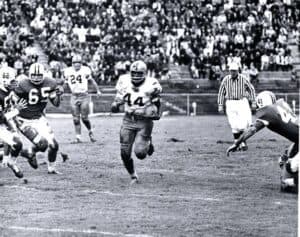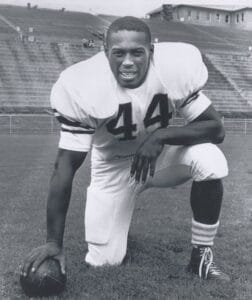Like No Man I Ever Saw
 Anyone who knows me knows I bleed orange. Syracuse Orange, that is.
Anyone who knows me knows I bleed orange. Syracuse Orange, that is.
As a kid, I attended Percy Hughes, a special school that, back in the day, butted up against the East side of the S.U. campus. At Westhill, I served as a statistician for the S.U. basketball team under Coach Fred Lewis. Then, as an undergraduate, I actually went to Syracuse. And now, as I find myself on life's victory lap, I live full-time in the Sheraton University on the Hill, in the shadows of the Carrier Dome, Marshall Street and the Hall of Languages.
As many also know, I love sports. Sports have been both a passion and a sanctuary for me. And the lifelong and tireless pursuit of my two great loves, S.U. and S.U. sports, has given me license to announce (proudly, I might add) that it’s entirely possible no man or woman alive has seen more Syracuse basketball and football games than I have.
In my time as an S.U. fan (that is, from 1964) I’ve seen them all. All the greats, and in both sports.
On the basketball side, I’ve beheld, live and in person, the greatness of Derrick Coleman, Rony Seikaly, Pearl Washington, Louis Orr, Roosevelt Bouie, Sherman Douglas, Lawrence Moten, Gerry McNamara, John Wallace, Tiana Mangakahia, of course, Carmelo Anthony – to name but a few.

And, in football, I’ve watched Orange legends like Larry Csonka, Jim Nance, Joe Ehrmann, Tommy Myers, Bill Hurley, Joe Morris, Art Monk, Rob Moore, Donovan McNabb, Donnie McPherson and, of course, Tim Green regularly bring thousands to their feet while utterly dominating the poor saps trying to stop them on the other side of the ball.
Yet, in all that time, the greatest I saw in each sport I was able to watch as an undergrad, knowing the two were more than just sports heroes to me. They were my schoolmates.

On a basketball court, there was, quite simply, no greater Orangeman than Dave Bing, the smart and slender kid from Washington, DC who came to Syracuse in the Fall of 1962 and changed forever both the city and its relationship to the game. What’s more, he ushered in an era of S.U. basketball glory that continues to this day.
Yet, as great as Dave Bing was, I’m not sure the single greatest – and certainly most exciting – student/athlete to wear orange during my time wasn’t a bowlegged little fireplug from New Haven, a soft-spoken halfback named Floyd Douglas Little.
At S.U., Floyd Little was, pure and simple, my man. To watch him follow a line of blockers, knowing he was looking for even a sliver of daylight before bolting through it, was as exciting as anything I’ve ever seen, before or since. And to watch him circle under a punt at old Archbold Stadium, and then explode upfield, cutting left, then right, then occasionally backward, making would-be tacklers miss and leaving others clutching at his tear-away #44 jersey, was as close to perfection as the rules and physics of the game allowed.
I watched Floyd every Saturday, of course, from my wheelchair, knowing I’d never be able to do anything like that. But that didn’t stop me from wondering what it would feel like to, just once, be able to dart around a football field so skillfully and unexpectedly that you could make hearts flutter at the mere possibility of what you might do next.

That’s one of the many reasons I was devastated recently to learn my friend and football hero, Floyd Little, had been moved to hospice, and that the cancer he’d managed to duck and dodge for so long was finally, at long last, taking him down.
I too, you see, am trying to cope with a body that's breaking down, and doing so faster and faster all the time. But in my case, that was to be expected. My body, if it was a car, would have been recalled decades ago. And I'd have demanded either a new one or my money back. But, at the very least, what I’m going through now is, really, just one more variation of what I’ve always gone through. And though one never really gets used to the physical pain, you at least learn to expect it and, on some level, deal with it.
But in Floyd’s case, it just seems so patently unfair for someone to go through what he's going through now when, at one point, his body and skills seemed a gift from the gods. And it pains me to no end to think of the many thoughts and emotions that must be swirling about in my former schoolmate’s head and heart.

And if I were with Floyd now, I would tell him, even as he lay there with his eyes closed and his heart barely beating, thank you. Thank you for the joy. Thank you for the memories. And thank you for making it possible for at least one young man in a wheelchair – a fellow S.U. student, at that – to every so often, so many Saturdays ago, come so close to perfection that it made him want to get up from his chair and dance for joy, or at least try.
Godspeed, Floyd Little. Peace be with you, my friend. And may you – like you’ve never done before – find the crack of daylight that awaits you and do with it what you did better than any man I ever saw. ###